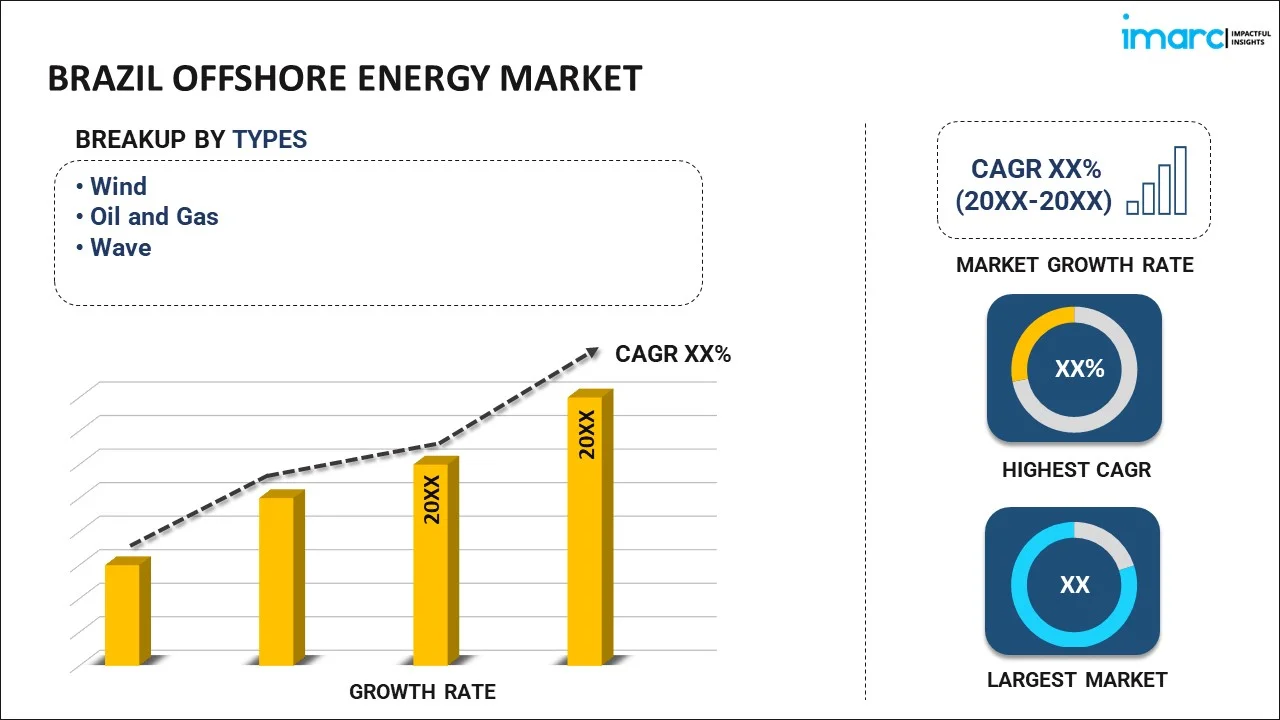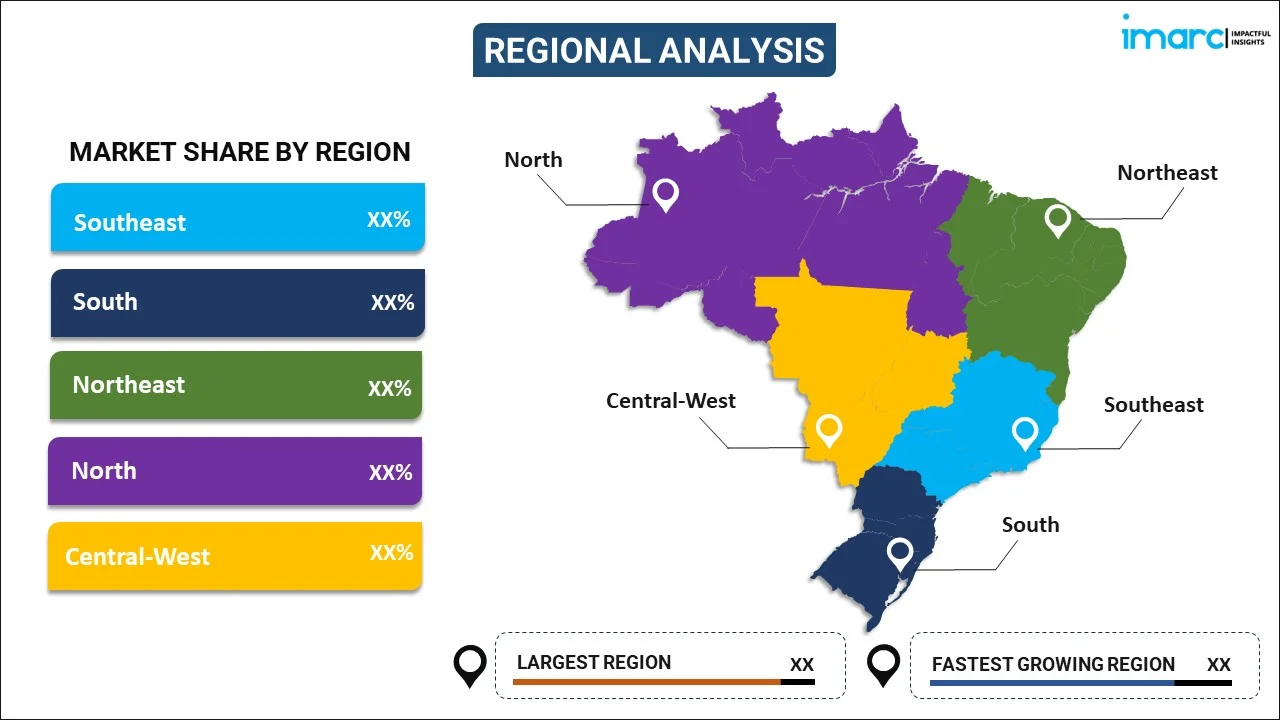
Brazil Offshore Energy Market Report by Type (Wind, Oil and Gas, Wave), and Region 2026-2034
Market Overview:
Brazil offshore energy market size reached USD 1.6 Billion in 2025. Looking forward, IMARC Group expects the market to reach USD 2.2 Billion by 2034, exhibiting a growth rate (CAGR) of 3.60% during 2026-2034. The increasing pre-salt reserves, the implementation of favorable government policies, advanced drilling expertise, presence of global energy leaders, rising domestic energy demand, port infrastructure enhancements, sustainable energy initiatives, and heightened global energy prices are some of the factors fueling the market growth.
|
Report Attribute
|
Key Statistics
|
|---|---|
|
Base Year
|
2025
|
|
Forecast Years
|
2026-2034
|
|
Historical Years
|
2020-2025
|
|
Market Size in 2025
|
USd 1.6 Billion |
|
Market Forecast in 2034
|
USD 2.2 Billion |
| Market Growth Rate 2026-2034 | 3.60% |
Offshore energy refers to the extraction of various forms of energy resources, such as oil, natural gas, wind, and even wave and tidal power, from beneath the seabed or from offshore renewable sources. The process of extracting offshore energy primarily involves drilling or installing infrastructure at sea, making it distinct from onshore energy production. One of the primary methods for offshore energy extraction is offshore oil and gas drilling, which involves drilling wells beneath the ocean floor to access reservoirs of oil and natural gas. These hydrocarbons are then transported to the surface, processed, and transported to various locations for consumption. Offshore oil and gas drilling plays a pivotal role in meeting global energy demands. Additionally, offshore wind energy has gained substantial prominence in recent years. The wind farms are constructed in coastal waters, where powerful winds can turn turbines to generate electricity. Offshore energy extraction, whether from oil and gas or renewable sources, has several advantages, such as it reduces the environmental footprint of energy production by minimizing the impact on terrestrial ecosystems. It also has the potential to yield high energy outputs, contributing to energy security and reducing greenhouse gas emissions. Moreover, offshore wind and tidal energy projects can create job opportunities and stimulate economic growth in coastal regions. Currently, there are various types of offshore energy sources available, including offshore oil and gas, offshore wind energy, and emerging technologies like wave and tidal energy.
Brazil Offshore Energy Market Trends:
Brazil's offshore energy market is experiencing significant growth due to a myriad of drivers, such as the country’s vast pre-salt reserves, which have boosted oil production capabilities, making it one of the top global players in deep-water oil exploration. Moreover, the consistent government policies in recent years have favored offshore investments, offering tax incentives and streamlined licensing processes, which is fueling the market growth. Additionally, the presence of major global energy players in the region contributes to technological advancements and capital investments, which is boosting the market growth. Furthermore, Brazil's energy demand is on the rise, necessitating the exploration of offshore resources to meet domestic needs, which is propelling the market growth. In line with this, there's a growing interest in diversifying energy sources, leading to explorations into offshore wind and other renewable sources, which is accelerating the market growth. Other factors, such as the country’s strategic geographical location and a growing trend towards sustainable energy practices, are stimulating the market growth.
Brazil Offshore Energy Market Segmentation:
IMARC Group provides an analysis of the key trends in each segment of the market, along with forecasts at the country level for 2026-2034. Our report has categorized the market based on type.
Type Insights:

To get more information on this market, Request Sample
- Wind
- Oil and Gas
- Wave
The report has provided a detailed breakup and analysis of the market based on the type. This includes wind, oil and gas, and wave.
Regional Insights:

- Southeast
- South
- Northeast
- North
- Central-West
The report has also provided a comprehensive analysis of all the major regional markets, which include Southeast, South, Northeast, North, and Central-West.
Competitive Landscape:
The market research report has also provided a comprehensive analysis of the competitive landscape in the market. Competitive analysis such as market structure, key player positioning, top winning strategies, competitive dashboard, and company evaluation quadrant has been covered in the report. Also, detailed profiles of all major companies have been provided.
Brazil Offshore Energy Market Report Coverage:
| Report Features | Details |
|---|---|
| Base Year of the Analysis | 2025 |
| Historical Period | 2020-2025 |
| Forecast Period | 2026-2034 |
| Units | Billion USD |
| Scope of the Report | Exploration of Historical and Forecast Trends, Industry Catalysts and Challenges, Segment-Wise Historical and Predictive Market Assessment:
|
| Types Covered | Wind, Oil and Gas, Wave |
| Regions Covered | Southeast, South, Northeast, North, Central-West |
| Customization Scope | 10% Free Customization |
| Post-Sale Analyst Support | 10-12 Weeks |
| Delivery Format | PDF and Excel through Email (We can also provide the editable version of the report in PPT/Word format on special request) |
Key Questions Answered in This Report:
- How has the Brazil offshore energy market performed so far and how will it perform in the coming years?
- What is the breakup of the Brazil offshore energy market on the basis of type?
- What are the various stages in the value chain of the Brazil offshore energy market?
- What are the key driving factors and challenges in the Brazil offshore energy?
- What is the structure of the Brazil offshore energy market and who are the key players?
- What is the degree of competition in the Brazil offshore energy market?
Key Benefits for Stakeholders:
- IMARC’s industry report offers a comprehensive quantitative analysis of various market segments, historical and current market trends, market forecasts, and dynamics of the Brazil offshore energy market from 2020-2034.
- The research report provides the latest information on the market drivers, challenges, and opportunities in the Brazil offshore energy market.
- Porter's five forces analysis assist stakeholders in assessing the impact of new entrants, competitive rivalry, supplier power, buyer power, and the threat of substitution. It helps stakeholders to analyze the level of competition within the Brazil offshore energy industry and its attractiveness.
- Competitive landscape allows stakeholders to understand their competitive environment and provides an insight into the current positions of key players in the market.
Need more help?
- Speak to our experienced analysts for insights on the current market scenarios.
- Include additional segments and countries to customize the report as per your requirement.
- Gain an unparalleled competitive advantage in your domain by understanding how to utilize the report and positively impacting your operations and revenue.
- For further assistance, please connect with our analysts.
 Request Customization
Request Customization
 Speak to an Analyst
Speak to an Analyst
 Request Brochure
Request Brochure
 Inquire Before Buying
Inquire Before Buying




.webp)




.webp)












